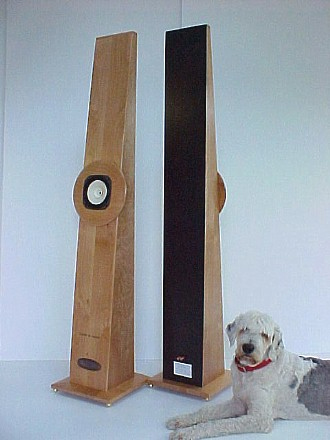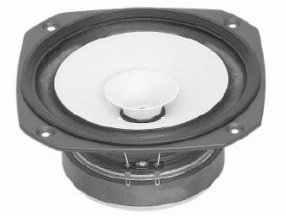You are reading the older HTML site
Positive Feedback ISSUE
14
july/august 2004
cain & cain
Abby loudspeakers
as reviewed by Francisco Duran

|
FRANCISCO DURAN'S SYSTEM: LOUDSPEAKERS ELECTRONICS SOURCE CABLES ACCESSORIES
|
A long time ago, on a visit to a high end audio salon, I peeked into the room that housed the pricier equipment and experienced an audiophile moment. In the listening chair sat a guy clutching the CD jewel case of Steely Dan's Aja on Mobile Fidelity. The look on his face was concentration incarnate. He was there to hear the difference between two solid state amps, both of which were very large, very expensive, and had enough razor-sharp fins to flail a passing warthog to shreds. The speakers, of course, were multi-driver affairs that were very hard to drive and sounded hard, brittle, and way off-timbre, though the bass was real tight.
For some reason, that memory passed through my brain as I listened to the Cain & Cain Abby loudspeakers for the first time, even though my experience could not have been further from what I saw and heard that day. The far simpler Abby system had the ability to draw me into the music much more, and I didn't need to concentrate as hard for it to happen. High power/low sensitivity gear has never really done it for me, and this is coming from someone who has owned several heavy and powerful sand amps! Replacing my newly acquired Dali Euphonia MS4s with the single-driver Abbys almost seemed unfair. They couldn't reach as high, go as low, punch so solidly, or sound as sweet. Nevertheless, the Abbys were able to transport me to that musical place we all seek.
I could use the fact that Steve Lefkowitz was the first to listen to the Abbys (Steve's review to appear soon) as an excuse to avoid describing them, but I will say that they are beautiful, and that the words "gorgeous," "tall," and "slim" also apply. They are constructed of solid alder wood. Their natural stain and clear finish made me wonder why anybody would want them in other colors, but they are available in hunter green, cobalt blue, and rosewood red. (Okay, the rosewood is beautiful, too.) In addition to the wood, these speakers are mostly made of paper plus a little metal. I believe that the absence of stuff like Kevlar, polycarbonate, or other space-age plastic is responsible for their organic sound.

The review pair was designated "Normal." The Fostex FE 166e drivers in the Normals are said to project music into the room more easily than the ones in the Nearfield model, which have a softer, lusher midrange and are meant for smaller rooms or situations in which the listener is sitting close to the speakers. I did try the Normals in a 12 x 12-foot room, but felt that they were better suited to my 12 x 20-foot room. Positioning them didn't present as many problems as other speakers I have used in this room. After speaking with Terry Cain and dancing about the room a bit with the speakers, a spot was found where they created a sharp image and a wide soundstage.
One thing that helped make setting up the Abbys easy was the fact that they required only one pair of speaker cables. The Cardas binding posts were icing on the cake, as were the excellent brass-colored spikes, which pierce the carpet better than most of those devices. As for power, even one of my 20-watt amps had more than enough power to drive these speakers to very loud levels. As sensitive as the Abbys speakers are (95dB), I heard no hums, buzzes, or unwanted noise of any kind through my system.
Confronted with high-sensitivity speakers with only one small driver in each box, I went easy on them at first, so the first discs to go into the player were of small-scale, acoustic music. The Abbys reproduced Buddy Guy and Junior Wells' 1991 release, Alone and Acoustic, sharply and cleanly. Through my tube amps, the Abbys also reproduced Guy's acoustic guitar with plenty of body and wood. I heard each note clearly, and dynamic changes were easy to follow. It was interesting to hear Guy turn his head or start to sing before he was positioned in front of the microphone. The Abbys easily revealed these spatial cues, yet they never sounded bright. They gave me the feeling that the recording session was a pretty laid back affair, with these two long-time buddies relaxing and making music they know well. Turning to the Lightnin' Hopkins disc, The Blues of Lightnin' Hopkins, as I often do, things were more straightforward. Hopkins was anchored front and center on this very well recorded disc. His clean guitar licks and expressive voice took me on a relaxed blues ride. The lyrics on these folk blues tunes conjured up images not unlike those of a Bob Dylan song (on a good day).
These simple speakers do not bombard you with audiophile qualities. Instead, they draw you into the music, yet they also display all of the detail and soundstage that an audio buff could want. Listening to the Abbys reminded me of when I was a kid, listening to a tube table radio set to my favorite station. I connected with the music, not the technology. The Abby drivers were passing most, if not all of the music to me, intact and complete.
After my initial fears about the dynamic capability of these speakers went south, it was on to the heavier stuff. My son has been discovering the joys of classic rock, so how about some Led Zeppelin, some ACDC, and a little Jimi Hendrix? As an audio dad, one of the great pleasures in life is hearing your son say, "Wow dad, those bands are cool"! This did not come about by brainwashing—I have avoided classic rock for years because I grew up on it.
How did "Good Times, Bad Times" sound on the Abbys? Not bad. Those Fostex drivers were flexing to accommodate Bonham's drumming and the top end of Page's Les Paul Sunburst. These clean, detailed speakers revealed a balanced and extended top end, with no obvious rolloff or lack of air. The lead part in "Communication Breakdown" was no problem. Vocals sounded articulate and intelligible. On "Purple Haze," I could tell easily that Jimi was saying, "'Scuse me while I kiss THE SKY," not "kiss this guy!" And when Bon Scott sang about being on the highway to hell, I believed him!
It should be obvious, given the design of the Abbys, that the drum kit was be lacking in weight and authority, but realistically, the sound was well balanced. What the Abbys lack in dynamic impact, they make up for in loudness. The level at which they break up is much louder than I want to hear. I did hear a satisfying sense of fullness on rock and jazz, although the fullness came on stronger the more I cranked up the volume. Nevertheless, my attention was quickly drawn back toward the music, where it should be.
At this point, I was simply putting on music that I wanted to hear. I was in the process of breaking in a cartridge for the Opera 1.0 turntable review, and it hit me that I was putting on about six or seven albums in a row and listening straight through them. Of course, a lot of the credit here is due to the Opera table, but it bears repeating that these speakers had the ability to keep my attention. Whether this is due to the crossover-less design, the single driver, or the combination, it was music first with the Abbys.
Out came Orff's Carmina Burana on Capitol, with Leopold Stokowski conducting, on a brand spanking new-old-stock LP I bought for $1 at a second-hand store in LA, still in the shrink wrap. Spinning it on the Opera turntable was loads of fun. This version of the piece proved interesting. There were several passages on the disc that seemed to be all midrange. Thinking that the Abbys were cutting off the extremes of the music, I set up the Euphonia MS-4s and replayed the disc. On the MS-4s, those passages had the same midrange-only sound. It wasn't the Abbys.
My son requested Ludwig's Ninth and I obliged by playing the version on London with Solti conducting. This was my first Ninth, so there will be no performance comparisons. The big soundstage that these speakers created in my room proved useful in the final movement. As long as I kept the volume at sane levels, nothing came apart, and we were able to follow the musical lines with ease. There was also enough bottom end for a satisfying listen. These speakers can rock when you call for it. A quick check of the bass on the Stereophile Test Disc 3 revealed that there was solid bass down to 63Hz and hardly any at 40Hz. I regret that I didn't have the opportunity to hear Cain & Cain's very cool-looking Bailey subwoofer. I think that would bring these speakers to a whole new level of musicality and fun.
Fun is what these speakers generate in spades. They have the usual audiophile qualities—detail, speed, precise soundstaging and imaging—but they also have something that far too much hi-fi gear doesn't have—the ability to draw you into the music. In this they are not unlike the Quad 57s. I am not saying that the Abbys are the equals of those great speakers, but their musical enticement is more alike than not. If you are shopping for speakers, I urge you to put the Abby Normals on your short list. Francisco Duran
Abby
Retail: $1500
Can & Cain
website: www.cain-cain.com/audio/
